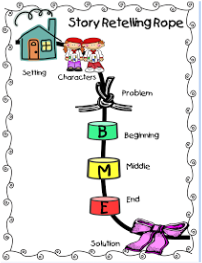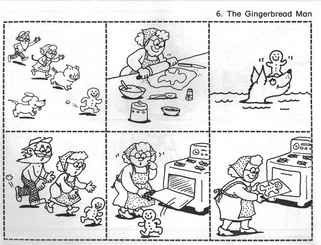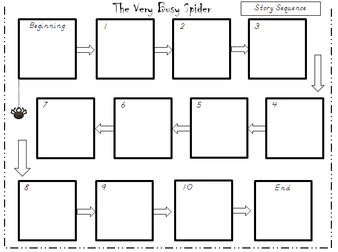What is Sequencing?
Reading Rockets (n.d). refers to sequencing as "the identification of the components of a story — the beginning, middle, and end — and also to the ability to retell the events within a given text in the order in which they occurred". Sequencing is an essential strategy in comprehension, and the overall purpose of reading is comprehension. This is why sequencing is so important in student's literacy development. Typically sequencing is done for narrative texts and it can be taught individually, in small groups, and as a large group. When students sequence a story, they often look for signal words such as: first, then, next, and finally. For example, first the boy reached into the cookie jar, then the cookie jar fell over and broke. Next the boy went to tell his mom he knocked over the cookie jar, and finally the boy's mom came to help him clean it up. These signal words tell students an order of events, and it helps students comprehend the story. For ELL students, these signal words are essential for students to learn. According to Echevarria, Vogt & Short (2014), "signal words are an effective way to provide English Language Learners (and other students) with words related to particular language functions such as comparing/contrasting, determining cause/effect...." (p.84). These two important concepts are important in comprehension as well. These signal words can also be differentiated based on the students English Language Proficiency level. For students that have high English language proficiency, they might use words such as prior to, eventually and previously. Beginning English speakers might use common signal words such as first, next, and later. Both levels of words help students sequence a story. When sequencing graphic organizers are often used to help students organize their thoughts. Echevarria, Vogt & Short (2014) say that "graphic organizers are beneficial for ELLS because they represent the main ideas and other content visually with just a few words" (p.208).
Visual Representations
|
This image is of cut and paste activity that can be done with kindergartners. Students cut out each square and then they have to sequence the events. Maybe the students read a story first to help them sequence, or maybe they have to put it in order themselves of how they think the story.
|
The image above is a sequencing map for the story, "The Very Busy Spider". In this map students draw a picture of what happens 1st, 2nd, 3rd, and so on.
|
|
This video was created by McGraw-Hill, a popular education publisher, and this video teaches students about order of events or sequencing. The example the video uses is the story of the tortoise and the hare, and This story is something many students are familiar with. In addition, the video also mentions the importance of cue words in sequencing. These words include: first, then, next, and finally.
|
This video was created by a classroom of young students, and they explain sequencing in their own words. They also relate sequencing to various things in their classroom like the 100s chart, calendar, and days of the week chart.
|
Content Area Examples
 This is a story telling rope that students can make for their own writing or for a story they have read.
This is a story telling rope that students can make for their own writing or for a story they have read.
Math- To incorporate sequencing in math, there are several things students can do. One example is that students could be asked to write down the steps of solving a given math problem. By doing this students will be able to better understand how they solved a problem because they have to break it down step-by-step. To help students organizer their steps, especially ELL students, a graphic organizer can be used for math sequencing.
Science- For a science lesson, students could be asked to record what happens to a science experiment over time. For example, each student could be given a seed, water, soil, and a light source. The students need to draw pictures and record what happens to their seed each day/week/month. This is sequencing because it is happening over time. Something happens first, second, next, last, and so on.
Writing- Sequencing writing is very similar to other content areas. Students could write their own narrative story and they can use signal words throughout their story.
Social Studies- Timelines are another way for students to do sequencing of events. With timelines students are sequencing events that happened in real life. Reading Rockets suggests that students create a timeline of important events in their life. This is something all students, even ELLs can do because it is their own life story. By sequencing, students are better able to understand the context of event.
Science- For a science lesson, students could be asked to record what happens to a science experiment over time. For example, each student could be given a seed, water, soil, and a light source. The students need to draw pictures and record what happens to their seed each day/week/month. This is sequencing because it is happening over time. Something happens first, second, next, last, and so on.
Writing- Sequencing writing is very similar to other content areas. Students could write their own narrative story and they can use signal words throughout their story.
Social Studies- Timelines are another way for students to do sequencing of events. With timelines students are sequencing events that happened in real life. Reading Rockets suggests that students create a timeline of important events in their life. This is something all students, even ELLs can do because it is their own life story. By sequencing, students are better able to understand the context of event.
References
Anovellife. (2011). Reading Comprehension Strategies: sequencing of events. [Video File]. Retrieved from https://www.youtube.com/watch?v=ZEWitdYB6_Y
Conley. (2011). The very busy spider story sequence activity. Love for Kindergarten. http://loveforkindergarten.blogspot.com/2011/10/very-hungry-spider-story-sequence.html
Dsenk. (2012). Gingerbread man. Kindergarten Nana. Retrieved from https://dbsenk.wordpress.com/2012/11/26/the-gingerbread-man/
Echevarría, J., Vogt, M. E., & Short, D. (2014). Making content comprehensible for Elementary English language learners: The SIOP model. Boston, MA: Allyn & Bacon.
McGraw-Hill. (2013). Introduction to reading skills: order of events. [Video File]. Retrieved from https://www.youtube.com/watch?v=HwUpSsTVCfY
Reading Rockets. (n.d.). Story Sequence. Retrieved from http://www.readingrockets.org/strategies/story_sequence
Conley. (2011). The very busy spider story sequence activity. Love for Kindergarten. http://loveforkindergarten.blogspot.com/2011/10/very-hungry-spider-story-sequence.html
Dsenk. (2012). Gingerbread man. Kindergarten Nana. Retrieved from https://dbsenk.wordpress.com/2012/11/26/the-gingerbread-man/
Echevarría, J., Vogt, M. E., & Short, D. (2014). Making content comprehensible for Elementary English language learners: The SIOP model. Boston, MA: Allyn & Bacon.
McGraw-Hill. (2013). Introduction to reading skills: order of events. [Video File]. Retrieved from https://www.youtube.com/watch?v=HwUpSsTVCfY
Reading Rockets. (n.d.). Story Sequence. Retrieved from http://www.readingrockets.org/strategies/story_sequence


